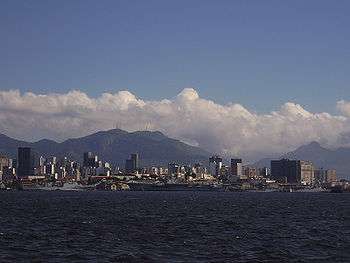Arsenal de Marinha do Rio de Janeiro
The Arsenal de Marinha do Rio de Janeiro (AMRJ) is a military organization of the Brazilian Navy. It is located in Ilha das Cobras, at the Guanabara Bay, in the city of Rio de Janeiro. The Arsenal is the main maintenance center and naval base of the Brazilian Navy, involving the design, construction and maintenance of ships and submarines, not only for the Brazilian Navy, but also to friendly nations. The AMRJ provides shipbuilding services both for military strategic reasons (mastery of technologies, seeking the reduction of external dependence), as economic ones, seeking nationalisation of components and the encouragement of domestic industry. Beside the AMRJ, the Brazilian Navy also has naval bases, that act in support of the Naval Districts, ships in transit or in specific technical areas. Among them are the Naval Base of Aratu, the Naval Base of Val-de-Cães and the River Base of Ladário.

History
The institution dates back to the installation of Arsenal do Rio de Janeiro, at the foot of the hill of St. Benedict. Created in December 29, 1763 by the viceroy Antônio Álvares da Cunha, first count da Cunha, had the intention to repair the ships of the Portuguese Navy. At the time, the capital of the colony was being transferred from Salvador to Rio de Janeiro, among other reasons, for a better protection of the gold that came from Minas Gerais by the Royal Road. With the arrival of the Portuguese Royal Family in 1808, the Arsenal started to be designated as Arsenal Real da Marinha or simply as Arsenal da Corte. In 1820, its dependencies began to expand to the Ilha das Cobras. After the independence of Brazil, faced with the need to organize and operate a Navy, the activities of the Arsenal became a priority. At this stage, started to be called as Arsenal Imperial da Marinha, better known as Arsenal de Marinha da Corte.
The nineteenth century watched the transition from sailing to steam navigation. During the so-called Era Mauá, the vessels were built in the shipyard in Ponta da Areia, in Niterói. Later, with the outbreak of the Paraguayan War, vessels for the Brazilian Navy were built in shipyards in the England and in the AMRJ. At the end of the conflict, Brazil had the most powerful navy in the South Atlantic,[1] and the AMRJ a valuable and experienced body of naval engineers, which provided the country the capacity to design and build its own ships. In 1938 two Arsenals coexisted: the Arsenal de Marinha das Ilha das Cobras (AMIC) and the Arsenal de Marinha do Rio de Janeiro (AMRJ). After 1948, only the Arsenal located in Ilha das Cobras survived, assuming the designation of Arsenal de Marinha do Rio de Janeiro.
Main achievements
Between the construction of surface units and submarines, and the activity of maintenance of the fleet, the AMRJ has its capacity recognized in Brazil and the world. Using advanced technology, professionalism and creativity, besides the countless daily tasks, in the last years, the AMRJ faced and overcome successfully the following challenges:
- 2005 - 2009 - two dockings and a revitalization program of the aircraft carrier São Paulo;
- 2005 - 2006 - transport of the submarine S Timbira from sea to workshop, using ferries and trucks ("load-in") and realization of its Programme of General Maintenance within a much lower time than the ones on Tupi and Tamoio's PMGs (General Modernisation Programs);
- 2005 - refurbishment of gearboxes of the Frigate Constituição;
- 2003 - docking of the aircraft carrier São Paulo;
- constructing the submarines Tamoio, Timbira, Tapajó and Tikuna (Tikuna's construction time was reduced in 11 months, recovering part of the delay, due to budget constraints);
- construction of the Niterói Class frigates: Independência and União;
- construction of the Inhaúma Class corvettes: Inhaúma and Jaceguai;
- Modernization Programme (ModFrag) of all Niteroi class frigate.
- large repairs in Argentine submarine ARA Santa Cruz, including cutting the hull.
The AMRJ was honored by the Pan American Institute of Naval Engineering for its contribution to the development of the Naval Engineering in the America, in 2002-2003, during the meeting in Havana, Cuba. The achievement was repeated in 2004-2005, during the meeting in Guayaquil, Ecuador.
Ships built in AMRJ
- The first ship built on the Arsenal was the ship D. Sebastião, finished in 1767.
- The last was the Corvette Barroso (V-34), in 2005.
- The oldest in operation: Monitor Parnaíba (U-17), finished in 1937.